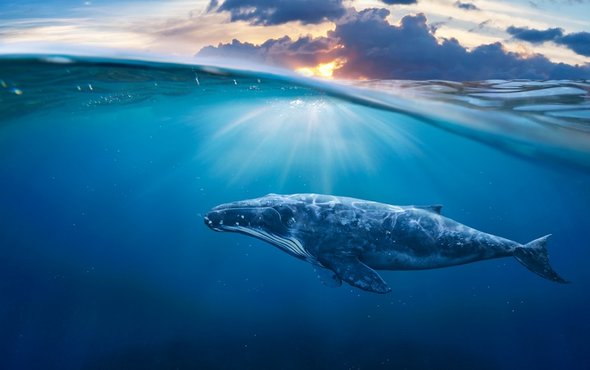(单词翻译:单击)
听力文本
This is Scientific American — 60-Second Science. I'm Annie Sneed.
Baleen whales are the gentle giants of the sea. Despite their colossal size, they feed on tiny creatures such as krill and zooplankton. That's because these whales, instead of teeth, have bristle-like structures in their mouth—baleen—which filters out small critters from big gulps of water. But the ancestors of baleen whales had a very different diet.
"So, the oldest whales that we know, these are the ancestors not just of the great whales like the Blue Whale and the Humpback Whale, but also of all of the dolphins in the sea today, they had fairly big teeth."
Felix Marx, a postdoctoral research fellow at the Royal Belgian Institute of Natural Sciences.
"And the most common idea is that they ate relatively large fish, and for some of the biggest ones... there are some studies that looked specifically of the wear of those teeth at the microscopic level, and they seem to suggest that they ate almost anything that they came across. The point is that they had big teeth that were really sharp, and that were even, relative to the size of their jaws, were relatively large, so they were really predators."

So where did baleen come from? Marx and his colleague Ewan Fordyce set out to answer this question. They analyzed the mouth of a 34-million-year-old fossil of one of the earliest baleen whales, called Llanocetus denticrenatus, found in Antarctica. And they concluded that Llanocetus had sharp teeth and large gums—but no baleen.
Their findings argue against one of the ideas about how baleen evolved—that at some point whales had both teeth and baleen. "Llanocetus is the first and it's the only specimen, the only species, the only archaic whale, that makes a very clear case that, no, this coexistence of baleen and teeth, as it was just imagined basically...based on what modern whales looked like, didn't work. It didn't exist in that sense." The finding is in the journal Current Biology.
So how did some whales go from chomping predators to filter feeders? "Baleen is effectively an outgrowth of the gums, and that probably only happened once the teeth had already been lost or maybe had been severely reduced. So we suggest this intermediate phase where you start with teeth and biting, then you start sucking your food, then because you suck in small things, you start to develop a filter and eventually you become a proper filter feeder."
Thanks for listening for Scientific American — 60-Second Science. I'm Annie Sneed.
参考译文
这里是科学美国人——60秒科学。我是安妮·斯尼德。
须鲸是海洋中温和的庞然大物。它们虽然体型庞大,但却以磷虾和浮游动物等微小生物为食。这是因为须鲸没有牙齿,它们的口中是鬃毛状结构的鲸须,这使须鲸可以吞一大口水然后把小生物过滤出来。但是须鲸祖先的饮食习惯与这些后代的差别非常大。
“我们已知的最古老鲸鱼,其后代不仅包括蓝鲸和座头鲸等大型鲸鱼,还包括今天海洋中的所有海豚,这些古老鲸鱼的牙齿相当大。”
比利时皇家自然科学研究所的博士后研究员费利克斯·马克思说到。
“最常见的观点是,这些最古老鲸鱼以相对较大的鱼为食,对于一些体型最大的鲸鱼,用显微镜专门观察其牙齿磨损程度的研究显示,它们似乎会吃掉遇到的所有东西。关键是它们拥有又大又非常锋利的牙齿,它们的牙齿与下颚相比也是相当大的,因此它们是真正的捕食性动物。”
那它们的鲸须是从何而来的呢?马克思和同事着手解答这个问题。他们对南极发现的一块3400万年前的须鲸化石进行了研究,并分析了它的口腔情况,这是其中一种最古老鲸鱼“刻齿拉诺鲸”的化石。他们得出的结论是,刻齿拉诺鲸拥有锋利的牙齿和巨大的牙龈,但是没有鲸须。
这一发现驳斥了有关鲸须演化方式的一种观点,该观点认为在某个时刻,鲸鱼同时拥有牙齿和鲸须。“刻齿拉诺鲸是能提供证明的首个且唯一的样本,是唯一的物种,唯一的古老鲸鱼,刻齿拉诺鲸能明确证明鲸须和牙齿并未共存过,人们当初基于现代鲸鱼的样子进行想象的情况并不属实。从这种意义上说,这种共生并不存在。”这项研究结果发表在《当代生物学》期刊上。
那一些鲸鱼是如何从咀嚼性捕食动物变成滤食动物的呢?“实际上,鲸须是牙龈的产物,可能只有在已经失去牙齿或牙齿严重脱落时才会发生。因此我们认为,这是一种中间阶段,在这种情况下,鲸鱼一开始用牙齿咬食,然后开始吸食食物,之后因为吸入了小生物,鲸鱼就开始进化出过滤器官,最终成为完全的滤食动物。”
谢谢大家收听科学美国人——60秒科学。我是安妮·斯尼德。
译文为可可英语翻译,未经授权请勿转载!
重点讲解
重点讲解:
1. instead of 代替…;而不是…;
We just had soup instead of a full meal.
我们没有吃全餐,只喝了汤。
2. filter out 滤除;滤掉;
Children should have glasses which filter out UV rays.
儿童应该戴上滤除紫外线的眼镜。
3. come across 偶然发现;偶然遇见;
I came across a group of children playing.
我碰到一群正在玩耍的小孩。
4. set out to do sth. 开始;着手;
We set out to find the truth behind the mystery.
我们开始着手揭开谜团背后的真相。


